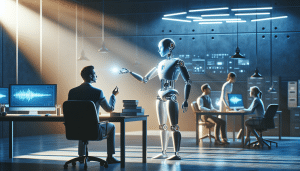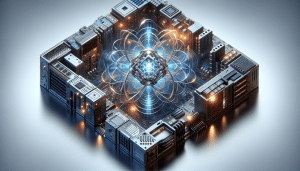AI Tools That Might Change How You Work
Aiden Foster November 4, 2025
Explore how artificial intelligence tools are reshaping modern workplaces, from automation and smart assistants to data analytics and creative solutions. This guide uncovers practical ways technology assists with everyday tasks, boosting productivity across industries while raising important questions about skills and adaptation.
AI-Powered Automation in Daily Tasks
Automation has become a familiar term in offices and production floors. Artificial intelligence now enables machines to perform routine, repetitive tasks with greater speed and fewer errors. Many organizations rely on tools that automatically handle data entry, customer support tickets, or even workflow approvals, freeing employees for more strategic work. This shift not only reduces operational costs but also influences job roles as some responsibilities are passed to smart systems. The trend is visible in finance, health records, marketing, and beyond, where tedious work is now often delegated to algorithms and software bots.
Behind the scenes, machine learning algorithms power much of this automation. These programs learn how a task is performed by analyzing lots of examples and then apply the acquired pattern to new information. Imagine a travel booking platform checking thousands of possible flights and hotels instantly, or payroll software ensuring tax deductions are made correctly every time. Such systems mean that employees, regardless of their role, increasingly interact with some form of automation in their daily routines. The continuous improvement in AI performance makes this technology a vital part of staying competitive in many industries (Source: https://www.nist.gov/artificial-intelligence).
Adapting to these developments does challenge organizations. Training is often needed, especially as some tasks once performed entirely by humans now require oversight, management, or the ability to use these new automated solutions effectively. Yet, as more businesses incorporate AI tools into basic functions, the promise is more time for innovation and less for tiresome data shuffling. Businesses and individuals alike are motivated to keep up with both the promise and practicalities of automation, knowing how it might impact roles and productivity in the near future.
Smart Assistants and Productivity Solutions
Smart assistants powered by AI have found their way into many offices and homes. Digital helpers like virtual meeting schedulers, voice-activated note-takers, and real-time language translators are reshaping what it means to be productive. With just a voice command or a few clicks, these tools organize calendars, send reminders, transcribe interviews, and help clarify communication barriers. This means tasks that often required manual coordination or tedious administrative work are now handled efficiently by software designed for seamless interaction (Source: https://www.nature.com/articles/d41586-018-05707-8).
The integration of smart assistants extends beyond the basics. Many software suites now incorporate AI-driven features that suggest relevant documents, draft responses to emails, or recommend ways to optimize workflows. In creative fields, some tools even recommend image edits or design templates based on the user’s style and past projects. This intertwining of artificial intelligence into both routine and creative processes makes work more manageable and sometimes even more enjoyable. The goal is to let workers focus on ideas and problem-solving rather than routine administration.
Widespread adoption, however, can present obstacles. Differences in how well specific software integrates with existing systems, privacy questions, and learning curves when switching to new tools can all create friction. Workers who embrace smart assistants, though, frequently report more organization and less stress as mundane burdens lift. By experimenting with these tools, individuals and companies gain a sense of what fits their style and what reshapes the very nature of daily operations.
Transforming Data Analysis and Decision-Making
Artificial intelligence has revolutionized the speed and accuracy of data analytics for businesses and scientists alike. Today’s organizations collect vast quantities of data from customers, machines, and operations, but the true challenge is making sense of it all. AI-powered analytics platforms spot patterns, anomalies, and trends that might otherwise escape human analysts. As a result, businesses can anticipate customer behavior, manage supply chains precisely, and even predict equipment failures before they happen. These predictive powers of AI are influencing how strategies are set and how everyday choices are made (Source: https://www.ibm.com/topics/data-analytics).
Machine learning, a subset of AI, plays a central role here. It enables systems to learn from data without being explicitly programmed for each unique situation. This flexibility means retailers get personalized product recommendations, banks detect fraud sooner, and health professionals analyze symptoms to aid in diagnosis. The sheer scale of analysis possible with AI opens opportunities that were out of reach just a few years ago. More importantly, these tools can adapt and improve as they are exposed to new information, maintaining relevance even as environments change.
Nevertheless, success in data-driven decision-making depends not only on technology but also on the ability of people to ask the right questions and interpret the outputs. Training in data literacy is increasingly important, even outside specialized tech roles, because understanding AI-driven insights can turn raw data into actionable improvements. Collaboration between data scientists, managers, and frontline staff ensures that the benefits of analytics are realized across the organization. This collective learning marks a crucial shift in the digital transformation journey for many firms.
AI in Creative Work and Content Generation
While coding and logistics may feel like natural homes for AI, artificial intelligence is pushing boundaries in creative industries as well. Music, art, design, and even writing are fields where machine learning models generate ideas, refine drafts, and simulate creative processes. Some platforms use deep learning to help designers quickly test ideas or photographers automatically enhance their images. In media, AI assists by generating article summaries, spotting trending topics, or structuring large content archives for easier discovery. The result: new creative possibilities mixed with efficiency gains.
For individuals looking to start creative projects or organizations trying to scale content production, AI brings freedom from repetitive, low-value tasks. Tools can assist with video editing suggestions, translate dialogues for global audiences, or even write code for graphics based on natural language prompts. Still, the balance between technology and human imagination remains essential. Most agree that AI serves as a creative partner, not a full substitute, supporting rather than replacing artists, designers, and writers (Source: https://hbr.org/2022/02/how-ai-is-changing-creative-work).
There are important considerations too. Some creatives express concern about losing personal touch or originality when artificial intelligence takes a larger role. Copyright, ownership of AI-assisted works, and ethical issues also enter the conversation. Addressing these questions while exploring the practical applications of new technology ensures that creativity remains at the heart of innovation, even as the definition of originality evolves in a digital age.
Skills, Adaptation, and the Future of Work
The pace of technological change means that adaptation is now a required skill. As artificial intelligence automates more tasks and powers new solutions, workers at all career stages find themselves learning how to collaborate with smart tools. Many educational initiatives—offered by universities, nonprofits, or technology firms—now include modules on AI basics, data fluency, and critical thinking about technology. These efforts prepare both current and future professionals to leverage innovations and remain resilient as roles evolve (Source: https://www.coursera.org/articles/ai-skills).
Workplace adaptation involves more than individual upskilling. Organizations must also foster flexible thinking, encouraging staff to explore new solutions and reimagine traditional business models. Some companies designate teams to experiment with AI tools, while others partner with external experts to revisit strategy. Success increasingly depends on fostering a culture of lifelong learning, where people are rewarded for staying curious and proposing creative uses of emerging technologies. This reduces resistance to change and opens opportunities for growth.
Navigating this future is not without anxiety. Concerns about job security, ethics, and fair access to technology prompt important policy discussions in government and industry circles. Many experts suggest that societies benefit when technological progress goes hand in hand with support for skill development, transparent governance, and open dialogue about challenges. As AI grows more capable, these conversations play a key role in ensuring that innovation brings shared, sustainable benefits.
Responsible AI and Ethics in Technology
No discussion of artificial intelligence is complete without a look at ethics and responsibility. The data AI systems use can encode bias and perpetuate inequities if left unchecked—an issue organizations and researchers are increasingly aware of. Transparent development practices, regular auditing, and collaboration with diverse stakeholders can help ensure that AI tools are trustworthy, fair, and beneficial to broader society (Source: https://ai.stanford.edu/education/).
Major technology companies and governments now publish guidelines and frameworks aimed at responsible AI adoption. These include principles about data privacy, informed consent, and algorithmic transparency. Most organizations find that robust ethical processes not only mitigate risk, but actually build consumer trust and foster innovation. Firms investing in ethical oversight often outperform those treating these issues as afterthoughts. Growing awareness suggests a trend toward greater accountability as AI technologies reach deeper into daily life.
Staying informed is part of responsible adaptation, too. Professionals, policymakers, and individuals benefit from learning where biases might arise, how data is collected, and what oversight mechanisms exist. Participating in these dialogues ensures that rapid advances in artificial intelligence align with shared values. By keeping ethics at the forefront of AI adoption, society can better harness technology’s potential for good while minimizing unintended side effects.
References
1. National Institute of Standards and Technology. (n.d.). Artificial Intelligence. Retrieved from https://www.nist.gov/artificial-intelligence
2. Nature. (2018). Rise of the machines: the AI revolution could crack the language barrier. Retrieved from https://www.nature.com/articles/d41586-018-05707-8
3. IBM. (n.d.). Data Analytics explained. Retrieved from https://www.ibm.com/topics/data-analytics
4. Harvard Business Review. (2022). How AI Is Changing Creative Work. Retrieved from https://hbr.org/2022/02/how-ai-is-changing-creative-work
5. Coursera. (n.d.). Top AI Skills Employers Look for Now and in the Future. Retrieved from https://www.coursera.org/articles/ai-skills
6. Stanford University. (n.d.). AI Education. Retrieved from https://ai.stanford.edu/education/








